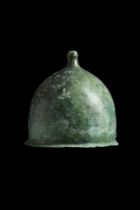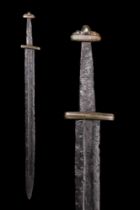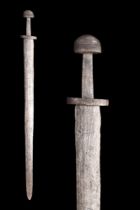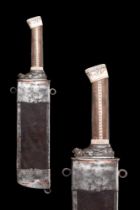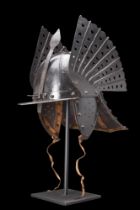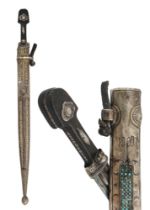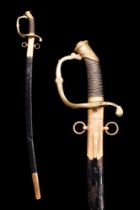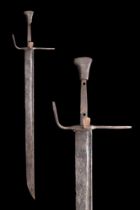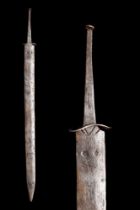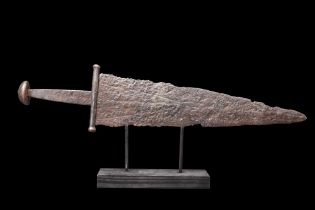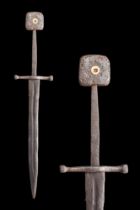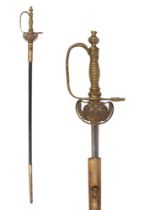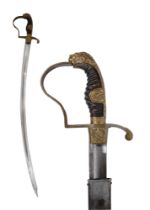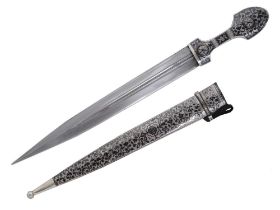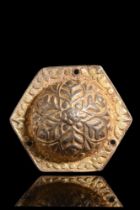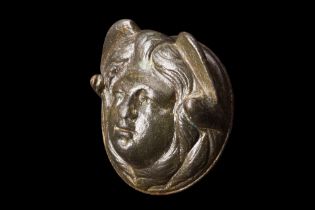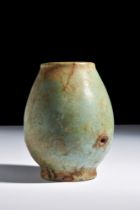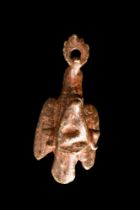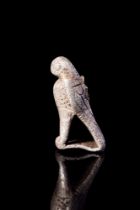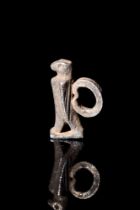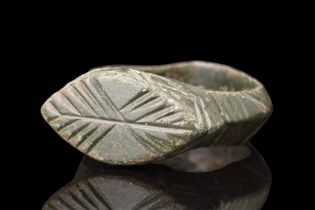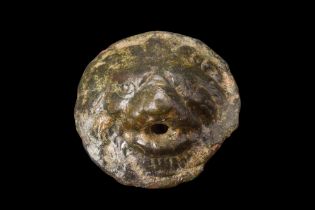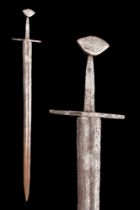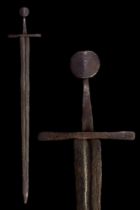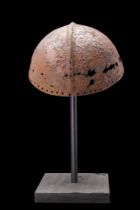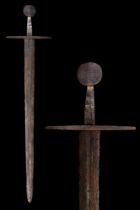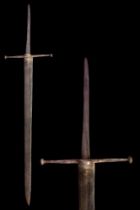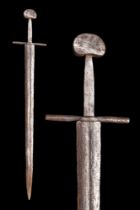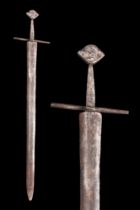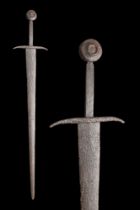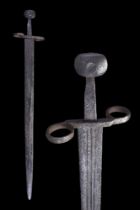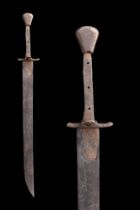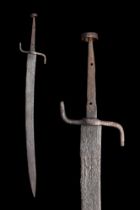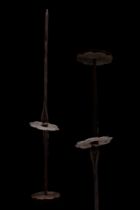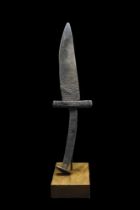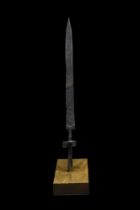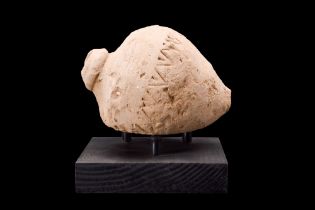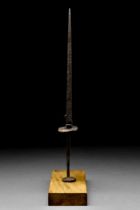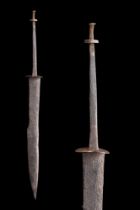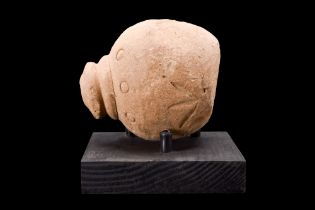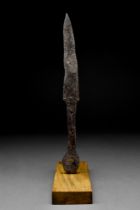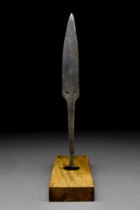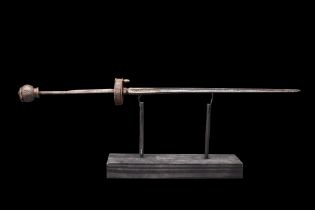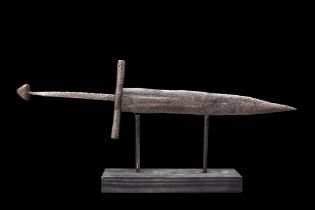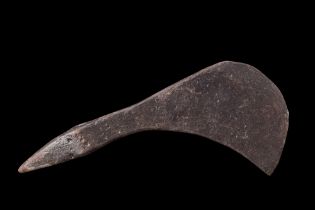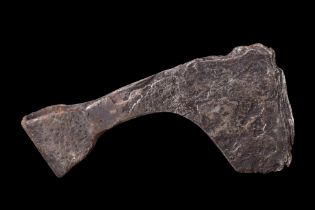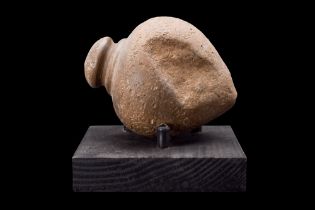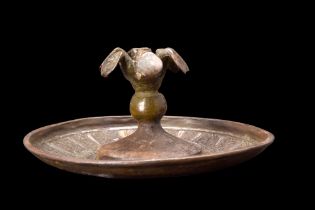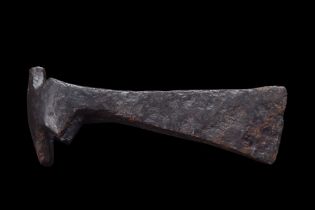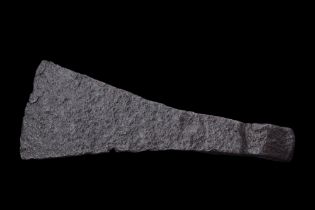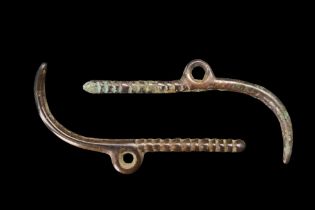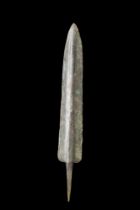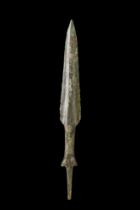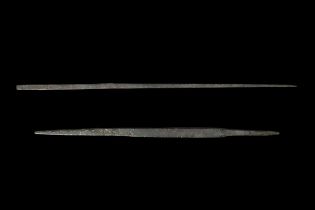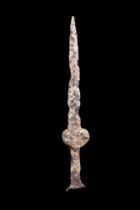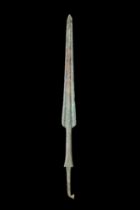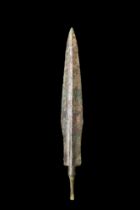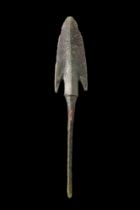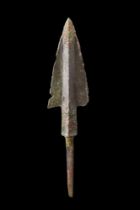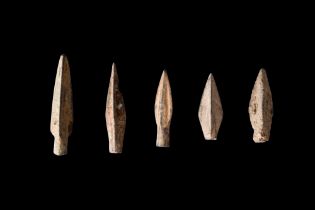Refine your search
Estimate
Category
Remove filter- Arms, Armour & Militaria (76)
Creator / Brand
Item Type
- Sword (25)
- Scabbard (13)
- Dagger (12)
- Round (11)
- Spearhead (8)
- Axe (6)
- Spear (6)
- Knife (4)
- Armour (3)
- Falchion (3)
- Grenade (3)
- Helmet (3)
- Insignia (2)
- Knives (2)
- Sabre (2)
- Sheath (2)
- Bayonet (1)
- Blunt (1)
- Bow (1)
- Cap (1)
- Cutlass (1)
- Fighting Knife (1)
- Flares (1)
- Hunting Knives (1)
- Keris (1)
- Kris (1)
- Mace (1)
- Military Insignia (1)
- Pin (1)
- Rifle (1)
- Seax (1)
- Yataghan (1)
Filtered by:
- Category
- List
- Grid
A subscription to the Price Guide is required to view results for auctions ten days or older. Click here for more information
Ca. 1st century BC - 1st century AD.A relatively light bronze legionary helmet with a bulbous domed bowl, small crest knob with a flattened top, p...
VIKING IRON SWORD
Ca. 900-1000 AD.An iron forged sword featuring a broad blade with parallel edges, tapering to a sharp point, ideal for piercing armor and deliveri...
MEDIEVAL VIKING IRON SWORD
Ca. 900-1000 AD.An iron sword In excavated condition, with a broad double-edged blade, the hilt comprising thick ovoidal cross-piece, flat slightl...
Ca. 1500-1600 AD.A steel hunting knife with a broad rectangular-shaped heavy blade adorned with hallmarks. The single-edged blade possesses remark...
Ca. 17th-18th century AD.Polish-Lithuanian Commonwealth – Saxony, 17th-18th century, period of the reign of August II the Strong, who was king of ...
The Caucasus, ca. 19th century AD. With a pointy blade with three grooves, the silver-mounted filigree-decorated scabbard is richly chiseled and d...
Ca. 19th century AD.A sabre sword. This exquisite weapon is a stunning example featuring a curved fullered blade with a pointed tip. The hilt is a...
MEDIEVAL IRON FALCHION
Ca. 1300-1400 AD.An iron falchion with a single-edged, asymmetric blade, with a short back edge, the hilt gently tapering to the left side ending ...
MEDIEVAL IRON SWORD
Ca. 1100-1125 AD.A hand-forged sword blade of a Viking or Norman type, comprising of a long, gently tapering blade with a straight double-edged bl...
MEDIEVAL IRON DAGGER
Ca. 900-1100 AD.An iron military dagger comprising a short triangular blade with thick midrib and tapering edges, narrow point, cross guard with c...
Ca. 1300 AD.An iron dagger with a slender hand guard and a square pommel decorated with floral inlay. The cross-style two guard has a slight centr...
Ca. 1855 AD.Russian M1855 court sword. Gilt-brass hilt and mounts, clam-shell features the Imperial Russian eagle. Flattened straight blade. The s...
Ca. 1915 AD.One of the variations of the Lionhead sword – the "Jawless" or "Half-lion head" where the lion has no lower jaw. Brass hilt with some ...
Ca. early 20th century AD.Silver mounted dagger with hilt and scabbard decorated in chiseling niello, straight double-edged blade with two fullers...
LATE ROMAN SILVER GILT PHALERA
Ca. 300-400 AD.A silver gilt phalera. Its form, a symphony of geometry, unveils a hexagonal shape that captivates the eye with its harmonious angl...
ROMAN BRONZE MEDUSA PHALERA
Ca. 100-200 AD.A hollow bronze phalera adorned with a relief face of Medusa, a mythological figure of ancient Greek and Roman lore. Medusa, known ...
RARE EGYPTIAN FAIENCE JAR
Late Period, ca. 664-332 BC.A faience jar anchored upon a circular base. This vessel exudes a timeless allure – its globular body elegantly merges...
Ca. 1st century AD.A bronze figurine of an eagle with its wings held back, grasping a head of a bull in its claws while holding a wreath in its be...
Egypt, ca. 30 BC-300 AD.A silver eagle amulet, crafted with exceptional artistry, depicts an eagle with its majestic wings folded, imparting a sen...
Egypt, ca. 30 BC-300 AD.A silver eagle with its wings gracefully folded, exuding a sense of regality and composure. Resting upon an integral and f...
Ca. 100-300 AD.A bronze finger ring featuring a round hoop, exhibiting a slight carination that adds a subtle visual distinction. The shoulders of...
ROMAN BRONZE LION HEAD PHALLERA
Ca. 100-200 AD.A cast bronze phalera formed as a lion's mask. The animal's head with a prominent nose and large eyes, an open mouth, and a detaile...
Ca. 1000-1100 AD.An iron sword with a distinctive Brazil nut pommel, Oakeshott type A. The cross guard is long, thin, and square-sectioned, in Oak...
MEDIEVAL SWORD WITH ROUND POMMEL
Ca. 1425-1550 AD.An iron sword Oakshott type ‘G1’ of a double-edged bevelled and pointed blade with shallow groove, straight cross guard, and inte...
VIKING IRON SKULL CAP
Ca. 9th-13th century AD.A rare iron skull-cap, crafted in the shape of a hemisphere to fit snugly over the human head. The design of this piece is...
Ca. 1025-1380 AD.A stunning iron sword Oakshott type ‘G’, with a wide blade almost parallel, then tapers down to a sharpish point. The blade is do...
Ca. 1425-1450 AD.An excellent forged-iron long sword with a broad blade tapering to a sharp point. The cross guard is of a ‘tommy bar’ type. The h...
Ca. 1100 AD.An iron sword with a distinctive Brazil nut pommel, Oakeshott as a type ‘A’. The cross guard is long, thin, and square sectioned, in O...
Ca. 1000-1100 AD.A hand-forged sword comprising of a long, narrow and gently tapering blade, square-section crossguard with clubbed finials, flat-...
MEDIEVAL IRON SWORD
Ca. 1300-1350 AD.An iron sword featuring a raised boss pommel, a long flat-section hilt, and a cross guard with curved tips on the ends towards th...
MEDIEVAL IRON SWORD
Ca. 1300 AD.An iron sword features a parallel double-edged blade, exhibiting a combination of strength and versatility in combat. The blade is cha...
MEDIEVAL IRON FALCHION
Ca. 1300-1400 AD.An iron falchion with a single-edged, asymmetric blade, with a short back edge. Cf. Oakeshott, Ewart (1980). European Weapons and...
MEDIEVAL IRON FALCHION
Ca. 1300-1400 AD.Falchion, with a broad single-edged, curved blade, a guard formed of a combined forward quillon and knuckle bow, each with a flat...
LATE MEDIEVAL IRON DAGGER
Ca. 14th-15th Century AD.A poniard with iron, disc like fittings that have scalloped edges. The blade is long and thin, much of the same proportio...
MEDIEVAL IRON KNIFE/DAGGER
Ca. 13th-15th century AD.An iron dagger with sleek single-edged blade exudes elegance and simplicity, while the straight cross guard and curved ta...
MEDIEVAL IRON DAGGER
Ca. 14th-15th century AD.An iron dagger of exceptional craftsmanship and beauty. The slender blade tapered to a fine point, speaks of its purpose ...
Ca. 800-1000 AD.A ceramic grenade also referred to as 'Greek Fire'. This hollow ceramic vessel consists of a piriform body, with a short neck and ...
Ca. 14th-15th century AD.An iron stiletto dagger with a diamond shape in section blade, circular cross guard, and a slim tang finished with a circ...
Ca. 1400 AD.A hand-forged single-edged dagger with triangular-section blade, elliptical guard with arched profile, tapering tang, and rondel-style...
Ca. 800-1000 AD.A ceramic hollow vessel featuring a domed spout for filling. A decorative register of punched etchings runs through the upper sect...
Ca. 13th-15th century AD.An iron short knife blade with rivetted tang and integral forged round pommel. The tang may have been inlaid with wood or...
Ca. 10th-11th century AD.An iron seax blade with a straight cutting edge and angled back, the tang offset from the blade. Its hilt would have been...
Ca. 1300-1400 AD.A fine rondel dagger made from iron with the signature disc-shaped guard and pommel. The blade is long and slim with a double edg...
Ca. 1200-1300 AD.An interesting iron dagger of a quite lethal form. Blade sharpened on each edge, Cross hilt, thin handle once supporting a wooden...
VIKING AGE IRON AXE HEAD
Ca. 900-1100 AD.An iron axe head, characterized by its asymmetric curved cutting edge and tapering cheek, exemplifies the sophisticated craftsmans...
VIKING AGE IRON AXE HEAD
Ca. 900-1100 AD.An iron axe-head featuring a downward-extending cutting edge and a tapering cheek leading to a butt with a round hole shaft. The d...
Ca. 800-1000 AD.A ceramic hollow vessel, with its distinctive acorn-shaped body, raised mouth, and domed rim. The vessel's smooth body, devoid of ...
SELJUK SILVER INLAID BRONZE LID
Ca. 1100-1200 AD.A bronze lid with a round shape features a recessed upper face, with a thick decorative band with silver inlaid decor. This band ...
MEDIEVAL IRON AXE HEAD
Viking Age, ca. 900-1100 AD.An axe head with a flaring blade, expertly forged from resilient iron, tapers towards the cutting edge, enhancing its ...
MEDIEVAL IRON AXE HEAD
Viking Age, ca. 900-1100 AD.An iron axe head, an embodiment of functional excellence, presents a captivating sight with its fan-shaped blade that ...
Western Asia, ca. 1200-700 BC.A rare pair of bronze amulets, each characterized by a round-section shank with ribbed features on one end and a cla...
ANCIENT BRONZE SPEARHEAD
Western Asiatic/Aegan, ca. 1200-700 BC.A bronze spearhead boasts a double-edged blade with parallel sides, skillfully tapering to a finely honed p...
ANCIENT BRONZE SPEARHEAD
Western Asiatic/Aegan, ca. 1200-700 BC.A bronze spearhead crafted with exceptional skill, it features a double-edged blade in a distinct leaf shap...
Western Asiatic/Aegan, ca. 1200-700 BC.A pair of bronze spearheads, each with elegantly shaped, slender blades. The blades culminate in a sharp, p...
SCYTHIAN ACINACES SWORD
Ca. 500-400 BC.An iron Acinaces-type sword. Its form, a study in sleek functionality, presents a pointed, elongated triangular blade that commands...
ANCIENT BRONZE SPEARHEAD
Western Asiatic/Aegan, ca. 1200-700 BC.Expertly cast as a single unit, this bronze spear showcases exceptional craftsmanship. Its slender blade ta...
ANCIENT BRONZE SPEARHEAD
Western Asiatic/Aegan, ca. 1200-700 BC.A bronze spearhead, distinguished by its long and slender form, manifests a prominent rib traversing its en...
ANCIENT BRONZE SPEARHEAD
Western Asiatic/Aegan, ca. 1200-700 BC.A bronze spearhead crafted with great care and attention to detail. This lentoid blade boasts a prominent m...
ANCIENT BRONZE SPEARHEAD
Western Asiatic/Aegan, ca. 1200-700 BC.A bronze spearhead with a distinctive triangular-shaped blade that gracefully tapers to a sharply pointed a...
Ca. 525-330 BC.A group of five bronze arrowheads represents an intriguing assemblage of projectile points. These arrowheads showcase a distinctive...

